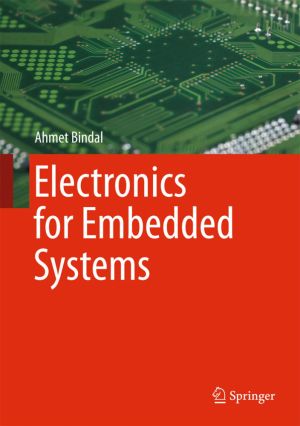Introduction to Embedded Systems
A Cyber-Physical Systems Approach
by Edward Ashford Lee, Sanjit Arunkumar Seshia
DescriptionTable of ContentsDetailsHashtagsReport an issue
The most visible use of computers and software is processing information for human consumption. The vast majority of computers in use, however, are much less visible. They run the engine, brakes, seatbelts, airbag, and audio system in your car. They digitally encode your voice and construct a radio signal to send it from your cell phone to a base station. They command robots on a factory floor, power generation in a power plant, processes in a chemical plant, and traffic lights in a city. These less visible computers are called embedded systems, and the software they run is called embedded software. The principal challenges in designing and analyzing embedded systems stem from their interaction with physical processes. This book takes a cyber-physical approach to embedded systems, introducing the engineering concepts underlying embedded systems as a technology and as a subject of study. The focus is on modeling, design, and analysis of cyber-physical systems, which integrate computation, networking, and physical processes.
The second edition offers two new chapters, several new exercises, and other improvements. The book can be used as a textbook at the advanced undergraduate or introductory graduate level and as a professional reference for practicing engineers and computer scientists. Readers should have some familiarity with machine structures, computer programming, basic discrete mathematics and algorithms, and signals and systems. 






Book Description
An introduction to the engineering principles of embedded systems, with a focus on modeling, design, and analysis of cyber-physical systems.The most visible use of computers and software is processing information for human consumption. The vast majority of computers in use, however, are much less visible. They run the engine, brakes, seatbelts, airbag, and audio system in your car. They digitally encode your voice and construct a radio signal to send it from your cell phone to a base station. They command robots on a factory floor, power generation in a power plant, processes in a chemical plant, and traffic lights in a city. These less visible computers are called embedded systems, and the software they run is called embedded software. The principal challenges in designing and analyzing embedded systems stem from their interaction with physical processes. This book takes a cyber-physical approach to embedded systems, introducing the engineering concepts underlying embedded systems as a technology and as a subject of study. The focus is on modeling, design, and analysis of cyber-physical systems, which integrate computation, networking, and physical processes.
The second edition offers two new chapters, several new exercises, and other improvements. The book can be used as a textbook at the advanced undergraduate or introductory graduate level and as a professional reference for practicing engineers and computer scientists. Readers should have some familiarity with machine structures, computer programming, basic discrete mathematics and algorithms, and signals and systems.
This open book is licensed under a Creative Commons License (CC BY-NC-ND). You can download Introduction to Embedded Systems ebook for free in PDF format (26.2 MB).
Table of Contents
Chapter 1
Introduction
PART I
Modeling Dynamic Behaviors
Chapter 2
Continuous Dynamics
Chapter 3
Discrete Dynamics
Chapter 4
Hybrid Systems
Chapter 5
Composition of State Machines
Chapter 6
Concurrent Models of Computation
PART II
Design of Embedded Systems
Chapter 7
Sensors and Actuators
Chapter 8
Embedded Processors
Chapter 9
Memory Architectures
Chapter 10
Input and Output
Chapter 11
Multitasking
Chapter 12
Scheduling
PART III
Analysis and Verification
Chapter 13
Invariants and Temporal Logic
Chapter 14
Equivalence and Refinement
Chapter 15
Reachability Analysis and Model Checking
Chapter 16
Quantitative Analysis
Chapter 17
Security and Privacy
PART IV
Appendices
Book Details
Title
Introduction to Embedded Systems
Subject
Computer Science
Publisher
MIT Press
Published
2017
Pages
585
Edition
2
Language
English
ISBN13 Digital
9780262533812
ISBN10 Digital
0262533812
PDF Size
26.2 MB
License

Related Books

This open book presents the results of the "Collaborative Embedded Systems" (CrESt) project, aimed at adapting and complementing the methodology underlying modeling techniques developed to cope with the challenges of the dynamic structures of collaborative embedded systems (CESs) based on the SPES development methodology.
In order to ma...

This book provides a comprehensive introduction to travel marketing, tourism economics and the airline product. At the same time, it provides an overview on the political, socio-economic, environmental and technological impacts of tourism and its related sectors.This publication covers both theory and practice in an engaging style, that will spark ...

Introduction to Neuroscience is designed for undergraduate students enrolled in introductory neuroscience courses. This book specifically targets students enrolled in Introduction to Neuroscience 1 and Introduction to Neuroscience 2 at Michigan State University and primarily contains topics covered in those courses.
This first edition will guide...

This book provides semester-length coverage of electronics for embedded systems, covering most common analog and digital circuit-related issues encountered while designing embedded system hardware. It is written for students and young professionals who have basic circuit theory background and want to learn more about passive circuits, diode and bi...

This book is exceptional in the sense that it provides an introduction to law in general rather than the law of one specific jurisdiction, and it presents a unique way of looking at legal education. It is crucial for lawyers to be aware of the different ways in which societal problems can be solved and to be able to discuss the advantages and disad...

This workbook was designed for the Introduction to Archaeology (ANTH 2339) class in the Department of Sociology and Anthropology, University of Texas at Arlington. It was created to provide exercises that supplement and expand on topics and issues raised in lecture. For each major topic, students complete exercises that serve a range of functions; ...

